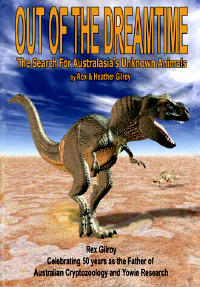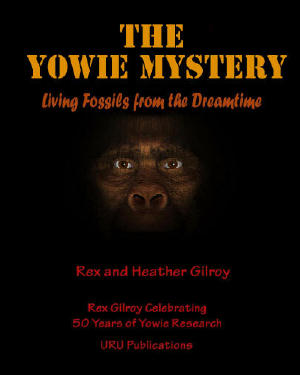
Rex Gilroy - 50 Years of Scientific Research
Photographs from Australia & New Zealand
There is something mysterious about the Australian bush never explained in the tourist brochures. For while this literature reveals the countless floral wonders, the magnificent scenery and the more common birds and marsupials, what is never mentioned is that it can also be very dangerous for the inexperienced to leave the beaten track. Nor does the tourist literature admit that to catch even a glimpse of some secretive and elusive species it is necessary to tread quietly in the Australian bush.
Native animals soon vanish at the sound of noisy humans on the approach. People have disappeared without trace in these vast, often inaccessible mountain ranges-the New South Wales Southern Alps, the Blue Mountains, the New South Wales north coastal and inland ranges-and the jungles of far north Queensland, to name but some areas. These vast, eerie, sometimes mist-shrouded mountain wilds are impenetrable bastions to the inexperienced and the day-tourist. There are remote wilderness recesses that no human has yet been able to penetrate.
And perhaps this is just as well, for these are the habitats of those mysterious, 'unknown' or long-thought-extinct native animal species never found in the tourist literature-species such as the 'Tasmanian tiger", the "Australian panther", the "Blue Mountains Lion", Giant Lizards, and the "Australian" Bigfoot hominid known as the yowie, to name but a few.
My wife Heather and I have backpacked into some of the wildest areas of the NSW Southern Alps, the Blue Mountains, northern NSW and Queensland's Cape York jungles in search of evidence of these 'unknown animals' (and hominids!), and it never ceases to amaze us how little most Australians really know about their country. We have seen regions where television documentary cameramen never tread due to the inaccessibility of these wilds-vast, silent mountain wildernesses that most people know nothing about. It therefore annoys me no end when scientists, journalists and laymen alike ridicule anyone who has claimed to have seen a Tasmanian tiger, panther, yowie or whatever, for these people usually know absolutely nothing of the habitat in which these creatures live.
Until they are willing to forsake the comforts of home and learn how to explore and survive in the remotest regions of the vast Australian bush, they are unqualified to pass judgement. In any case, they have never bothered to study the evidence, and refuse to do so for it is not a recognised subject in the scientific textbooks. Yet despite their attitude, Australia's 'unknown animals' continue to be seen. The study of worldwide animal species either still unknown to science or else thought long-extinct but which might still exist, is called cryptozoology. Regardless of the many scientists who believe it is a waste of time to pursue such 'mythical' creatures as the panther, giant monitor lizard, yowie, etc., the thousands of sightings reports I have collected from Australia and its neighbouring Pacific islands are more than enough evidence to convince me that many rare and secretive creatures, both land- and sea-dwelling, still await scientific discovery and identification.

It is a field of research not always guaranteed to win friends. My relatives regard me as 'mad'. The scientific community 'blackballed' me long ago. But have I lost any sleep because of all this? Certainly not! For even if I fail to find physical proof of the yowie or any of our Australian 'unknown' animal species, my wife and I have had the satisfaction of visiting and seeing remote, unknown and spectacular Australian wilderness regions that average Australians have never seen. So, dear reader, if you ever thought that giant lizards were only found on Komodo Island, that plesiosaur-type aquatic reptiles were confined to Scotland's Loch Ness, that dinosaurs were extinct, or that relict hominids were confined to America's Pacific North-West and the snowy wastes of the Himalayan mountain ranges, then hold on to your armchair! You are now going to be forced to accept that Australia possesses a whole menagerie of 'unknown' creatures, ignored for far too long and begging for recognition.
Rex Gilroy - 50 Years of Scientific Research
Looking back over my 50 years of research on the Yowie mystery, I see an evolutionary pattern in my work, beginning with the youthful enthusiasm of a teenager gathering old Aboriginal and early settlers stories of encounters in the bush with the “hairy man”, to the beginnings of my earliest field investigations and footprint finds; how I at first believed that the “hairy man” was some form of longhaired bipedal primate, which might be a surviving population of Gigantopithecus blackie which had made its way into Australia during the Pleistocene period. Yet I eventually realised that the cast footprints of the Yowie that began appearing in the 1960s, and also those recovered during the early 1970s, were more hominid than primate. At the same time I was beginning to uncover recently-manufactured crude stone implements from remote areas of the Blue Mountains. These, together with Aboriginal accounts of the “hairy men and women” being able to make fire and cook their food, soon led me to realise that I was dealing with remnant populations of living Homo erectus.
This belief was meanwhile being reinforced by discoveries first with my late father, Mr W F [Bill] Gilroy, and later by my wife Heather and I, of actual fossil skull-types of Homo erectus over a wide area of Australia, mostly in areas once inhabited by the “hairy people” according to Aboriginal traditions. I learnt also that ‘Yowie’ was but one of many, indeed a great many names throughout Australia, by which these beings were known to our Aborigines. In fact, I discovered that these names all identified any non-Aboriginal race with which they once shared the continent, be they average modern human height beings, pygmies or giants. All these names meant “hairy man”, “hairy woman” or “hairy people”, and they were all called such not because they possessed long body hair, but because they wore cloaks of kangaroo and other marsupial [fur] hides, just like the Aborigines in early historical photographs which can still be seen today.

Thus as my information and evidence grew I was able to discard previous ideas on the physical appearance and identity of the Yowie. A similar evolution of my theories, both on the origins of the Yowie and of pre-Aboriginal hominid evolution as a whole, can be seen in the way that my ideas have changed over the years as my collection of fossil hominid skull-types grew. In September 1969 I recovered a 52mm tall giant hominid lower back premolar tooth at a fossil site now covered by Westmead Children’s’ Hospital in Sydney’s west. The discovery of my first giant hominid fossil footprint followed in April 1970 at Mulgoa, at the eastern base of the Blue Mountains. Then in May 1972 my late father found the mineralised endocast of a large ‘archaic’ Homo sapien skull at an old Pleistocene site at Tarana, just west of the Blue Mountains; followed by my own discovery of a smaller endocast of a ‘late’ Homo erectus skull-type about 30 metres away in the same strata, demonstrating upon various grounds to be discussed further on in this book, that Homo sapiens were already present in Australia by 300,000 years ago, and that they shared the land with their ‘father’, Homo erectus.








